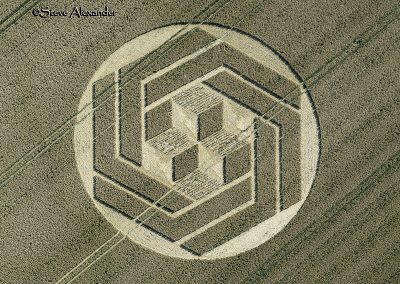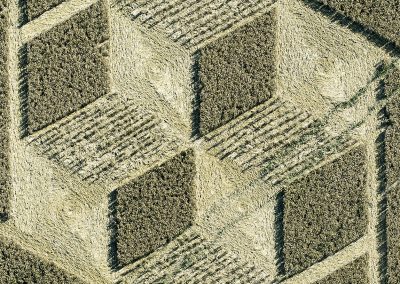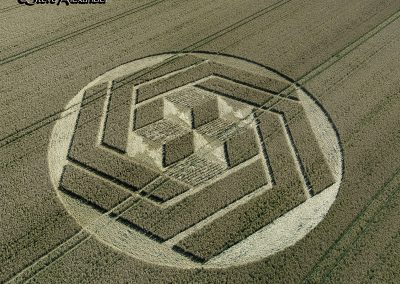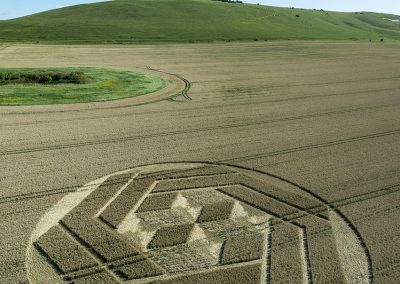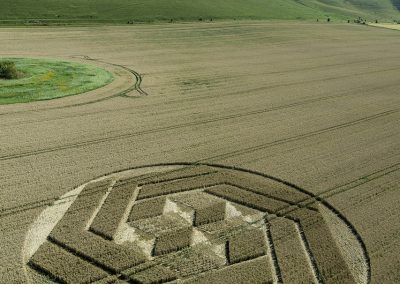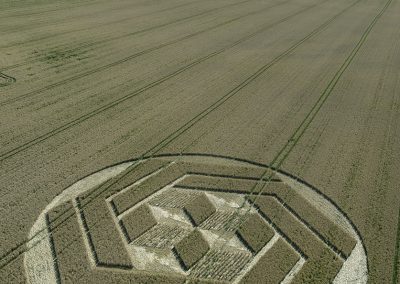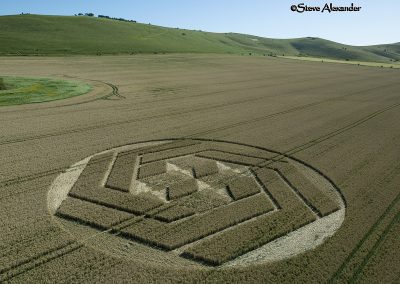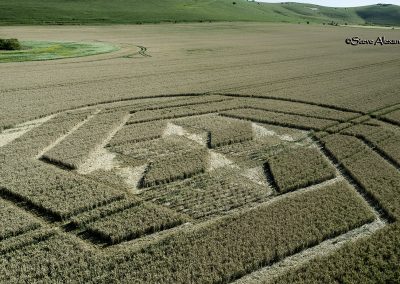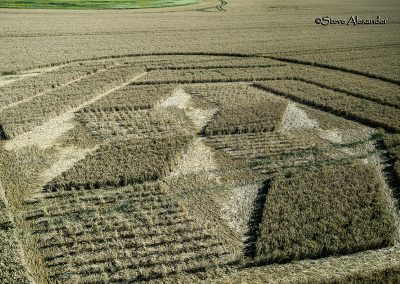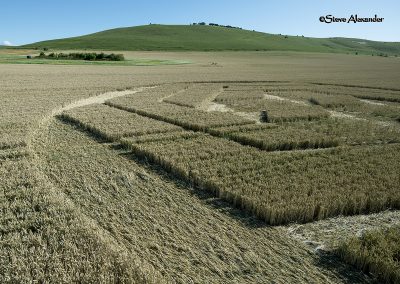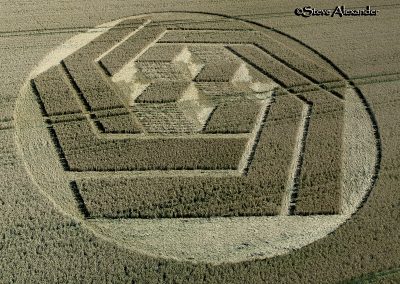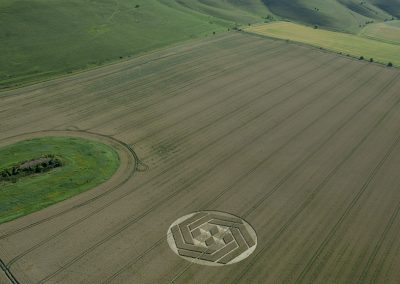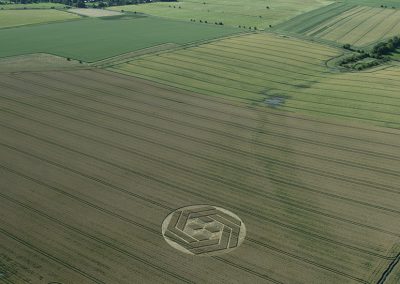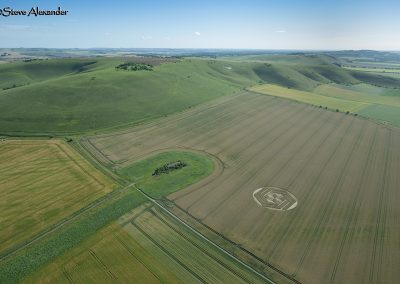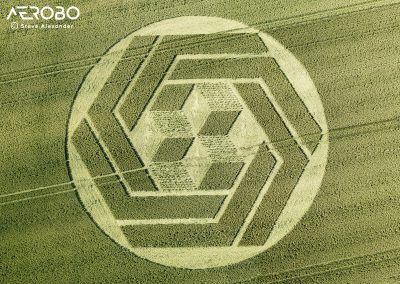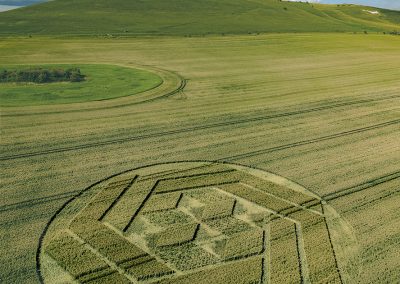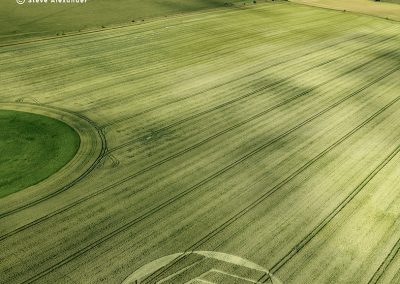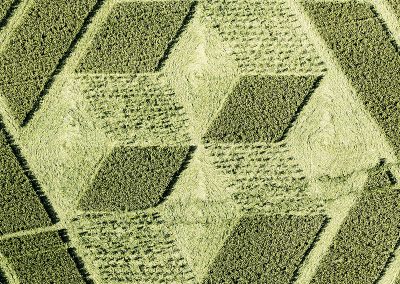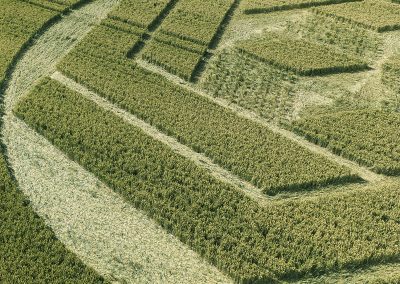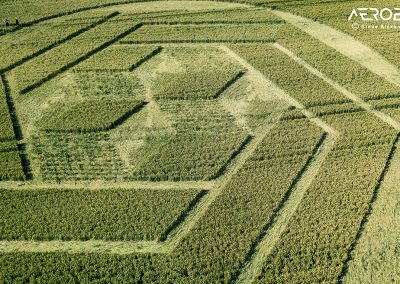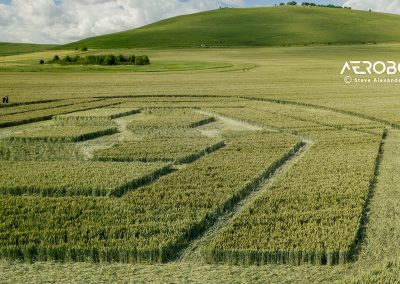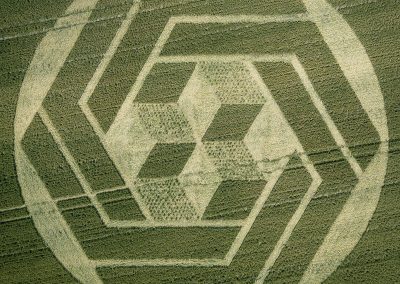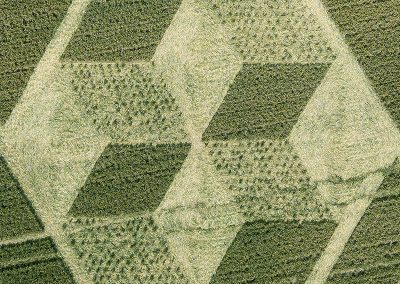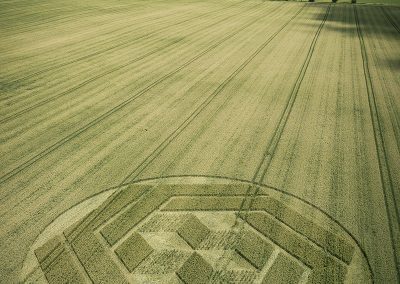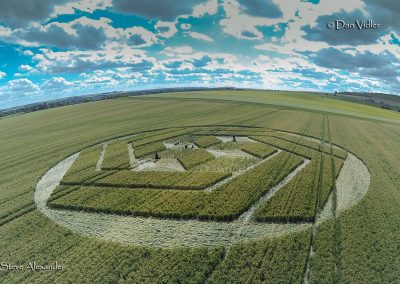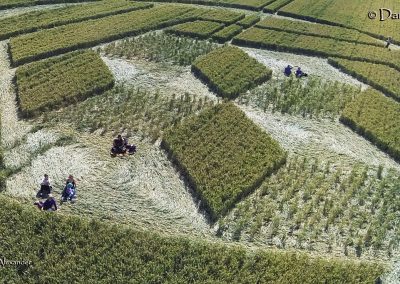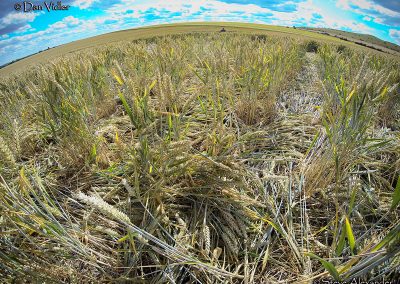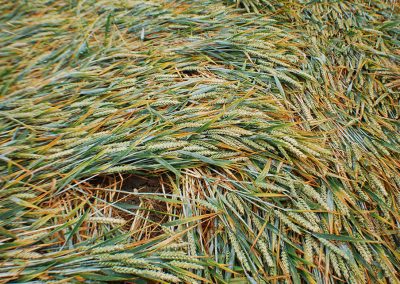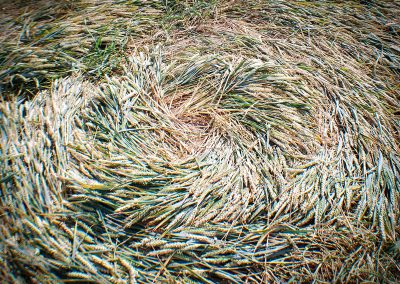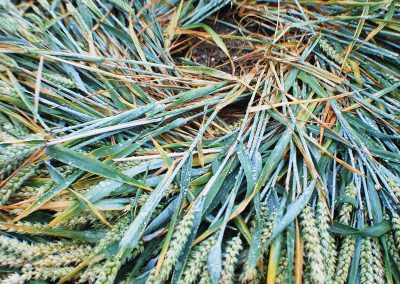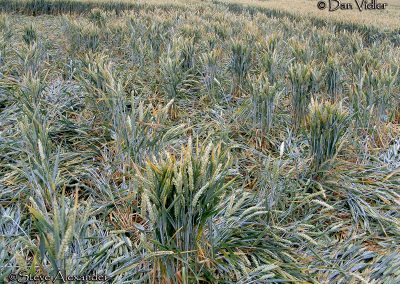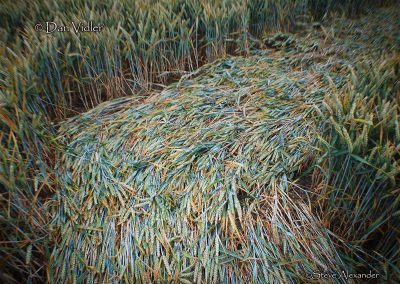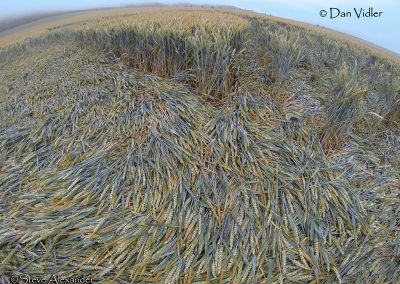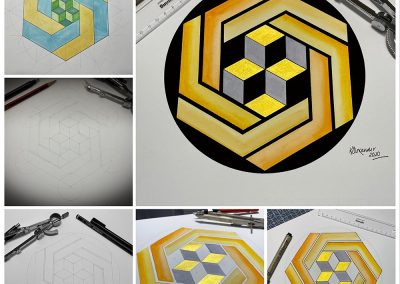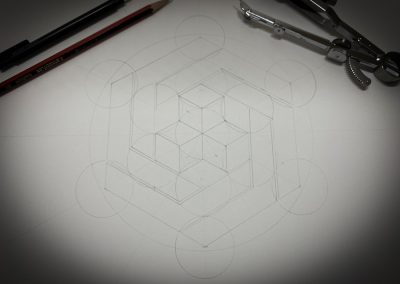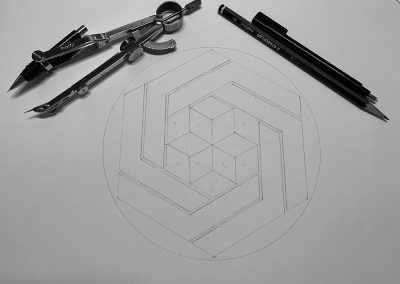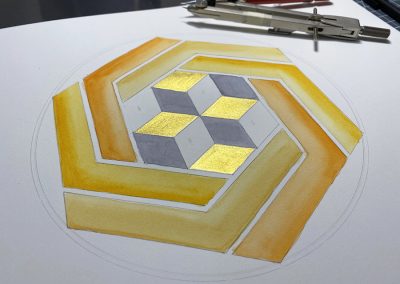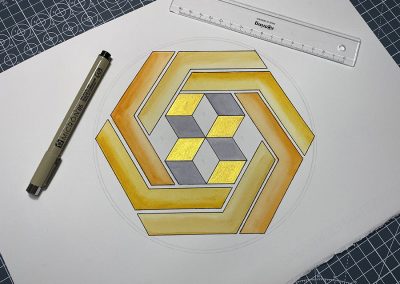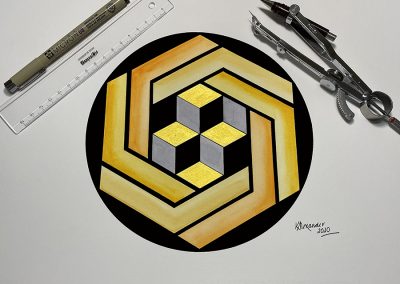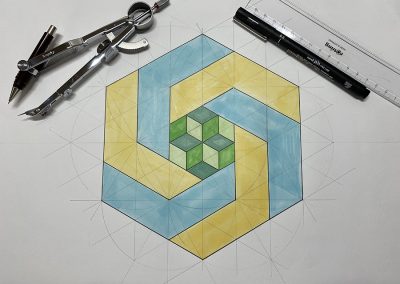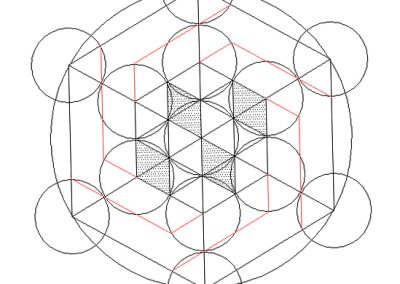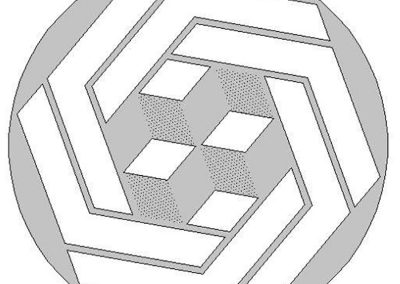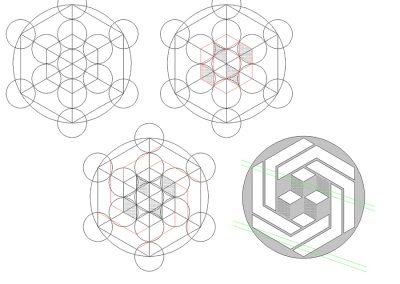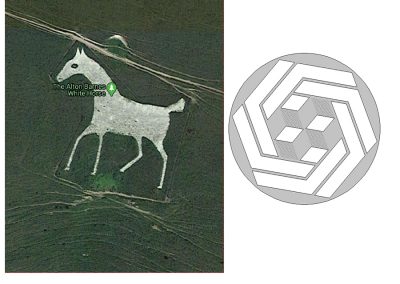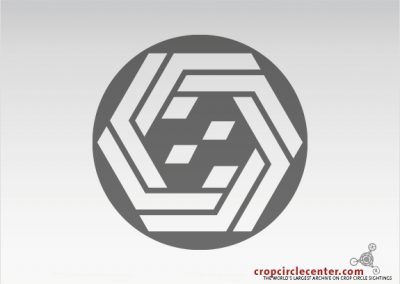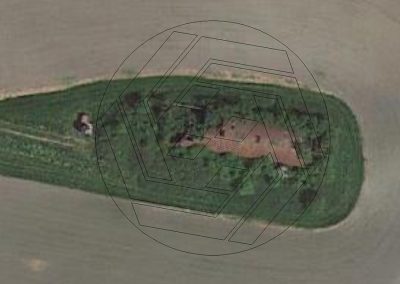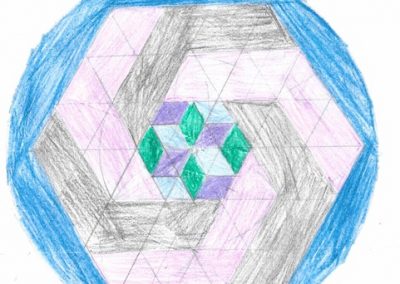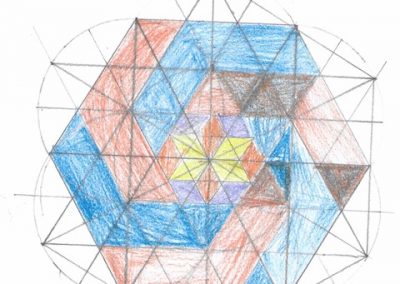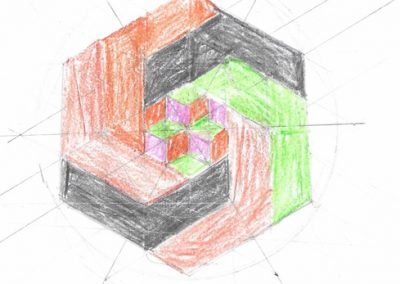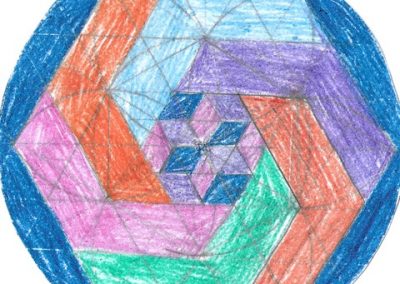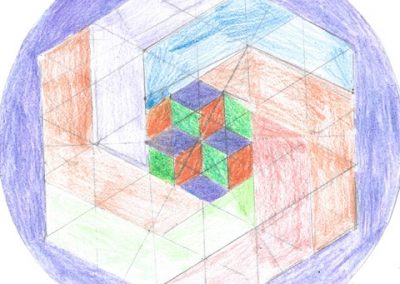Stanton St. Bernard, Wilts.
(Close to Alton Barnes white horse)
Detail & Location: This circle was reported on the 7th of July. It is in a field of green wheat and measures approximately 200ft in diameter. See the Google Maps link for precise location.
Update: Finally on the 20th of July, we were able to take to the skies for the first time in 2020 after lockdown restriction were eased somewhat in the UK. Please enjoy the pictures we were able to take of this formation two weeks after its arrival.
Crop Circle Reporting and Covid-19: After considerable thought and consultation, we have decided we will not be censoring crop circle locations during the Covid-19 pandemic. There are no current restrictions in place in the UK that call for a blanket ban on visiting the countryside. We consider the reporting of crop circles to be in the spirit of journalism, and censorship to be an anathema to that spirit. Therefore, we will be treating the crop circle community as adults and asking everyone to approach the information carefully and responsibly. This will include not visiting the circles if the farmer has not given explicit permission to do so and should permission be given that they practice social distancing by staying 2 metres away from fellow visitors. It would be our very strong advice that visiting the crop circles on the ground should be kept to an absolute minimum for now. However, because we know that the location of any given circle can be important to researchers and those that record the circles from the air, we will continue to share what we know.
Flying during the Covid-19 Pandemic: As yet, because of the current pandemic, we have not been able to take to the air to record the crop circles as we usually would. We are however, very confident that the restrictions keeping us grounded at present will be lifted before too long and we will be able to cover the rest of the season as usual. In the meantime, we are every pleased to have teamed up with the excellent AEROBO (Art in Flight) who will be helping us collect images and drone footage of the latest crop circles to share on the website.
Visiting: As far as we are aware no permission has been given to visit this crop circle. Please do not visit this circle. Thank you.
History & Connections: The fields that lie below Milk Hill, close to Stanton St Bernard have hosted many crop circle over the year. This one lies close to the old WW2 aircraft hangar in the field. There was a circle in the adjacent field at the end of last summer. This is prime crop circle country.
Design & Symbolism: See the Geometry Gallery below for a full write-up on this formation.
Visiting the Circles? If you are thinking of visiting any crop circles this summer, please read our Visiting the Crop Circles section. It’s full of useful information and etiquette for visiting the countryside and the crop circles. Please remember that you should not enter any fields without the express permission of the farmer and you will need to be aware of and abide by any restrictions in place in the UK in response to the Covid-19 pandemic.
Click here for Copyright Information about the reproduction of images on this website.
Please Help to keep us Flying in 2019: If you have enjoyed looking at our pictures and information please consider making a small donation to keep us flying. There are so few of us left regularly recording the circles it’s really important that we continue. And while some now use drones to record the circles, it is important that there are still images taken from aircraft where the best quality camera equipment can be used and images that include the broad vista of the landscape can be taken. This kind of photography is expensive and it gets harder with each passing year to raise the funds we need to continue our work, but if everyone who regularly looked at this website made a small donation we would meet the funds we need. You can make a donation here.
NOTE: Some of the images below are beautiful landscape scenes. Click on each image to enlarge them and see the whole picture.
Important Thanks:
Steve and I would like to thank AEROBO for their photography of this circle.
Dan Vidler for permission to use his excellent ground shots on this website. You can see more of Dan’s photography and crop circe ground analyses on his website: www.ukcropcircles.co.uk
Dan Hudson for his additional drone photography – more of Dan’s work can be seen on his Instagram feed.
Image Licencing
We can supply high resolution images of many of our photographs and the sky is the limit as to what they can be used for! Choose from our extensive library or contact us to commission aerial photography for your project.
Geometry Gallery
A Deepening of Perspective
by Karen Alexander 2020
Six and the Circle
A question that is often asked of me is why so many crop circles are six-fold in design, it is by far the most popular number found in crop circle geometry.
It is an interesting question and one to which I didn’t really have answer. The cynical might insist that six-fold geometry is the easiest - but that would be, erm cynical.
As I've pondered on this question, if there is an answer to this (to which there very well may not), perhaps it lies somewhere in the relationship between six and the circle. The pleasing and natural way a circle divides into six is to do with the relationship between the radius of a circle and its circumference.
Anyone who has drawn a circle with a compass will know, that once you open your compass and draw your circle on the page, that to divide that circle into six equal sectors you need not adjust the compass at all. By placing the compass pin on the circumference of you circle you can swing the compass round to cross the circumference, once that simple mark is made you can walk the compass around the entire circumference and make 5 additional marks - therefore diving your circle into six. Clearly this relationship is a natural function of the circular form. Given this relationship, it is perhaps little wonder that the number six is as prevalent in a subject that has the circle at its heart?
Always in a circle, the radius is twice that (x2) of the diameter and the relationship between the diameter of the circle and the circumference is mediated by the transcendental number Pi. Pi is the unknowable spirit at the heart of the circle, like the Divine which it traditionally represents, there is something ineffable about the circle, something that seems to defy, or is some how beyond our solid, always reconcilable dimension of reality.
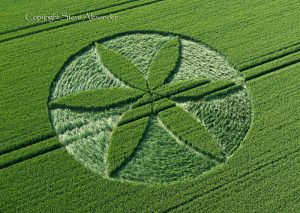
Seed-of-Life design - Yatesbury, Wilts 2013
In these modern times the pattern made by six equidistant circles around a central seventh is known as the Flower-of-Life, but this pattern has been known for much longer than the modern pop-geometry movement - when it might have been more accurately described as the Pattern of Creation - or Creation Diagram. The reason for this being its symbolic connection to the six days of creation and the seventh day of rest described by many of the Worlds religions, as the time it took the Divine to create the Heavens and the Earth. This seemingly simple pattern packs some pretty big symbolic punch.
That the circle is Divine, there can be little doubt, but clearly sixiness is next to Godliness!
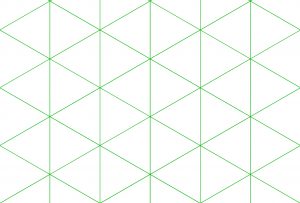 Isometric Projection
Isometric Projection
These days we take for grated the ability to render the illusion of three dimensions on a flat (2D) plane - on paper for instance. We marvel at the the depth of a scene or landscape in paintings and artworks, but it wasn’t always so. This ability was developed (relatively) recently during the renaissance 1300-1400 approx. Before this artists had used linearity to convey many things happening at once in a work of art. The creation of a vanishing point was one of the first types of ‘depth’ top be used in painting.
Creating one point projection (a vanishing point) is a largely geometric exercise, a rudimentary geometric framework is devised on which the artist ‘hangs’ his scene. A vanishing point is created by having many lines that converge in a single point, usually, but not always, at the centre of the composition - this creates the impression of distance.
The renaissance saw a reemergence of the geometric, not just as a utility for artists but in true renaissance style as a philosophy in its own right. The use of hidden geometries in paintings, such as the golden section, in both rectangular and spiral proportions (amongst other ratios) added both spiritual and philosophical ‘weight’ to the composition.
This could equally be said about the crop circles. In many ways the crop circles seem to do something similar there is often an exoteric geometry to the composition, then sometimes a hidden one. This is something the renaissance masters learned from both the ancients of Egypt and Greece and from the master-artistic-geometer herself - mother nature.
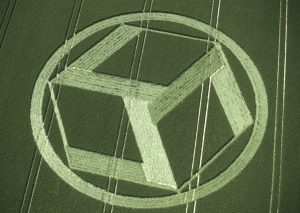 Allington1999
Allington1999
It was at Allington in 1999 that the crop circle phenomenon presented us with an image depicting depth perspective. The image was a cube in isometric projection. The isometric grid has been around in an non-formalised form for a while before it was formalised in the late 1700s. During the 1900s and the industrial revolution, this grid allowed for architects and designers to render 3D images on paper with relative ease. The grid is essentially an unbroken arrangement of equilateral triangles organised as a series of hexagrams. This particular grid, can be used to great effect (with the help of colours/shades) to pick out images that appear three dimensional. In the case of the Allington Cube, a hexagram was used to achieve this. There were other formations that followed, also containing cubes that used the same methodology. Then things changed.
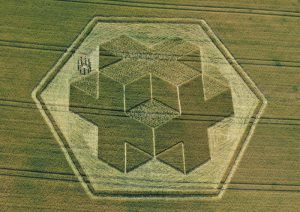 Cley Hill 2010
Cley Hill 2010
Classically, the crop circles have presented us with two types of crop - standing and flattened. That was until 2010. Before then, we have had crop that had been woven, knotted and beautifully laid in swirls and radial rings, but all these wondrous renderings were essentially (as far as the overall pattern was concerned) in the flattened category of crop.

The 'third' or 'liminal' state of crop in the 2020 Cley Hill formation
Then a formation appeared at Cley Hill in the summer of 2010 which for the first time used a flattened/half standing effect in the crop to represent a third ‘texture/shade’ of crop in a 3D design. This was taking the idea of isometric projection in the crop circles to the next level. If flattered crop could be considered black and the standing crop white, then this third state of crop might be considered grey.
As you can see form the pictures, this added yet a further deepening of image - but it has not been seen again until now.
Stanton St. Bernard 2020
The arrival of the formation at Stanton was significant because (for the second time only) it used this half standing/half flattened state of crop to represent a deepening space or perspective in the design. It is exactly ten years since this was last used.
This ‘grey’ area is interesting symbolically, it seems to imply not just a deepening of perspective, but it is itself a liminal colour/shade, neither one thing or an other, neither black or white, standing or flattened , but something in-between. It is revealing (literally) - the re-opening of something. Intuitively this feels very significant.
As you will see from the ground images in the gallery below (by researcher Dan Vidler), at ground-level this effect is quite bewildering, these liminal sections (for want of a better description), are comprised of standing clumps of wheat with the crop flattened and swirled around them - almost like the tiny dots of a pencil. 2020 is turning out to be an utterly fascinating season, with moves toward higher numbers and now this significant deepening of perspective in the geometry of the formations, the summer feels somehow precipitous.
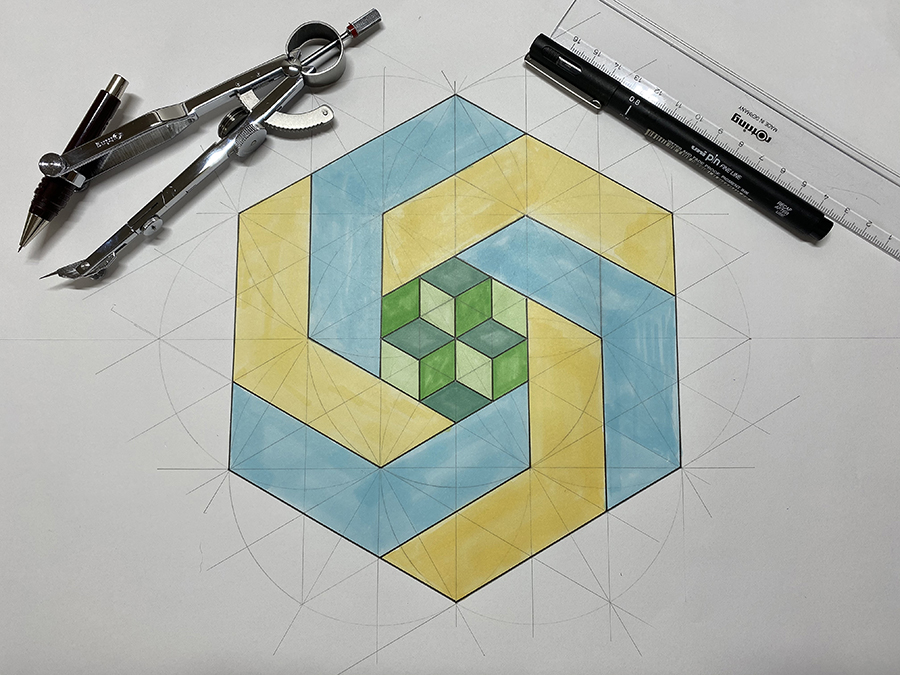
Drawing the Stanton Circle using an Isometric Grid
Drawing the Stanton St. Bernard Crop Circle
Drawing an approximation of the Stanton St. Bernard formation on an isometric grid is possible. In fact the students in researcher Dan Vidler’s class (he’s a school teacher) did just that - you can see some of their excellent drawings in the gallery below! I'd like to thank Kaya, Megan, Jacob, Feddie and Lily-Mae for their beautiful drawings! Young people drawing crop circles warms my heart.
However, as you will notice from my attempt, the proportioning isn’t quite right. Even allowing for spaces between the elements, the cubes in the centre are proportionally too small.
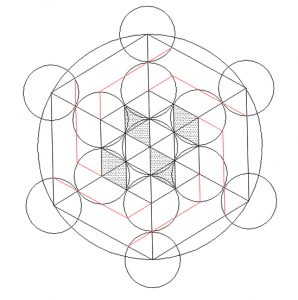
Stanton circle proportioned using the Metatron's Cube method - Peter van den Burg
Crop Circle geometer Peter van den Burg uses a variation on the Metatron’s Cube design to proportion the formation and I think this is the much better fit. This is interesting as they are both hexagonal systems, but different enough to create a significantly different proportioning of the design. I also used this method when making my own painting.
Symbolically, I feel this is significant too. The crop circle is based on a hexagonal framework linked to the spiritual Metatron’s Cube, rather than the prosaic, functional isometric grid. This, I think, tells us something significant about the nature of the construction and the phenomenon.
Final Thoughts
This crop circle is hugely significant because of the ‘liminal crop lay’ used. The Divine circle, the perfect six, the geometric framework of the angelic Metatron’s Cube, combine to speak to me of a spiritual deepening at work here, one we have not seen for 10 years, yet is at work again right now.
It continues to be a very strange time that we are living through right now, such upheaval and anxiety on so many levels. That the crop circles continue to appear provides a thread of continuity and dare I say hope. Despite everything, I am enjoying this season immensely!
Thanks & Credits
This article would not have been possible without the generous help of a handful of very important people. I would like to thank some of my crop circle cognoscenti for their help in forming these ideas: Steve Alexander, Peter van den Burg & Jonathan DeVierville
Text | Hand-drawn Images by Karen Alexander.
With special thanks to Peter van de Burg for his thoughts, perspectives and analysis. You can see more of his great work on his Facebook page Geometry of the crop circles.
Golden Section Proportioners by Scott Onstott.
Diagram by Bertold Zugelder.
Additional Drawings by: Kaya, Megan, Jacob, Feddie and Lily-Mae
Further Thoughts by Peter van den Burg
Date
07.07.2020
Crop
Wheat
Visiting
No permission has been given to enter this circle.
Google Maps Link


